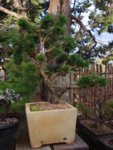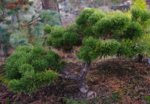Jzack605
Chumono
I grabbed a mugo pine nursery stock today. Awesome little tree I think has a lot of potential. The cultivar is Jakobsen and grown by Iseli nursery; a grower I hold in high regard. Not 100% sure where I want to go yet so looking for suggestions. It’s a bit of a clump right now but I promise the main stem has good movement. Could I do an initial styling to expose that movement in the main stem, open it up and repot this year? If so what would be the best method of approach?











